Women and the bicycle
By Claire Jones
In the mid 1880s, the emergence of a new, relatively stable and easy to ride ‘safety bicycle’ provided women with a chance for mobility, increased independence and freedom from the confines of the home. Women took to it with gusto and, in the decade of the 1890s, the new ‘bicycling craze’ swept through Britain, Europe and America. But not everybody was convinced of the desirability of women on wheels. Critics warned about the dangers of cycling to women’s health and moral propriety, others worried about its implications for society at large. Would these ‘free’ or ‘new’ bicycling women become sexually outré and masculinised , turning their backs on traditional family values and undermining the natural authority of men? If so, such daring women were nothing short of a threat to the well-being of the race and of the nation as a whole.
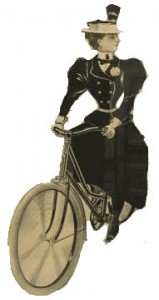 The safety bicycle was designed to specifications that we would recognise today. It had two equal -sized wheels, a diamond- shaped frame, inflated tyres (much more comfortable!) and pedals driving a chain. Manufacturers looking for more customers made much of the special women’s version which had a dropped-frame, higher handle-bars and no crossbar. This, they stressed, allowed women to ride with all due feminine grace and modesty, their skirts accommodated and kept away from the mechanism of the bike and dirt of the road.
The safety bicycle was designed to specifications that we would recognise today. It had two equal -sized wheels, a diamond- shaped frame, inflated tyres (much more comfortable!) and pedals driving a chain. Manufacturers looking for more customers made much of the special women’s version which had a dropped-frame, higher handle-bars and no crossbar. This, they stressed, allowed women to ride with all due feminine grace and modesty, their skirts accommodated and kept away from the mechanism of the bike and dirt of the road.
The safety bicycle’s predecessors earlier in the century were the high-wheeled cycle (with an enormous wheel at the front and a small one at the back) and the tricycle. High-wheelers were notoriously difficult to balance and control and were generally held to be entirely unsuitable for women. Towards mid-century the tricycle became more common and was preferred for women – but still women who rode them attracted a degree of ridicule and they were not an option for any but the headstrong and well-heeled. Some female entertainers featured a bicycle in their acts and this, too, did little to encourage respectable women concerned for their reputations to take up the past time.
Women on wheels - a revolution too far?
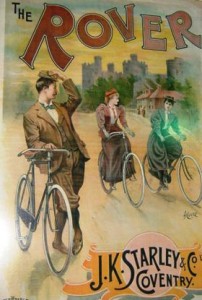 Before the 1890s riding a bicycle was seen as an essentially masculine activity and when women began taking it up in any number they became a target for conservative attack. Cartoonists in right-wing periodicals such as Punch found it irresistible to satirize bicycling women as mannish, incompetent figures of fun.
Before the 1890s riding a bicycle was seen as an essentially masculine activity and when women began taking it up in any number they became a target for conservative attack. Cartoonists in right-wing periodicals such as Punch found it irresistible to satirize bicycling women as mannish, incompetent figures of fun.
The ridicule directed at women was founded on anxieties that ran deeper than just the humour of women aping what men did well. Science and medicine at the end of the nineteenth century defined women in terms of their less robust bodies and fragile nervous systems. A woman had to be constantly on her guard, doctors warned, against both physical and mental over- exertion , especially during menstruation when ‘heavy brainwork’ as well as physical activity was particularly unwise. Women were advised to consult their doctors before taking up the bicycle and warned not to take their new hobby to extremes. The consequences of failing to take care could be dire: ill-health, failure of childbearing capacities and mental break-down.
Sexual awakening
There was also another anxiety about bicycling women, one sometimes couched in obscure language. Girls and women, it was feared, may get some inkling of sex from riding a bicycle and, as a result, their innocence and sexual purity would be threatened. Riding astride anything had always been problematic - girls sitting astride while playing with toys such as a hobby horse was frowned upon and it was partly because of sexual concerns that women rode side-saddle on horses. The bicycle posed particular anxieties. The angle of the saddle could cause women to become aware of sexual feelings before marriage and so awaken in her carnality and unfeminine sexual desire. The problem was exacerbated if women leaned forward, rode fast or did not maintain an upright posture when riding. Special ‘hygienic’ saddles with no inner core that could rub against a woman’s ‘delicate parts’ were offered by manufacturers to circumnavigate this problem.
Another worry concerned chaperones who were being dispensed with by mobile younger women; men and women riding together with no surveillance threatened chastity and the rules of respectable courtship.
All these issues pointed to women thwarting patriarchal authority and usurping men’s freedoms. Victorian gender codes stressed women’s dependence and passivity and these ideals were now under threat . For traditionalists these anxieties were all the more alarming because they came at the same time as women’s campaigns during the late nineteenth century for the vote and increased educational and employment opportunities. Indeed, the liberated ‘new woman’ of the 1890s – often a graduate of one of the new Oxbridge colleges for women - was often identified explicitly with the bicycle.
Women answer back
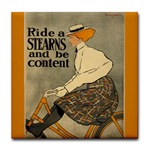 Of course, opposing voices spoke up in defence of bicycling women. Medical fears were countered by arguments to the effect that cycling made women healthier and stronger, helping them to overcome the nervous and mental disorders that women were prone to and making their bodies ready for maternity and childbirth.
Of course, opposing voices spoke up in defence of bicycling women. Medical fears were countered by arguments to the effect that cycling made women healthier and stronger, helping them to overcome the nervous and mental disorders that women were prone to and making their bodies ready for maternity and childbirth.
Bicycle manufacturers and advertisers defused concerns about sexual impropriety by aligning their products with images of attractive, feminine - and always upright – women, often with their skirts flowing gracefully behind them. Despite this, female riders helped move forward dress reform which, in England, was promoted by the Rational Dress Society. By the mid 1890s women were wearing ‘rationals’ for cycling, often baggy trousers that gathered and fastened below the knee or ,for the less daring, divided skirts (culottes). But women were urged by riding manuals and journalists alike to always look feminine and ‘womanly’ in the saddle and special cycling outfits were not welcomed by all.
The bicycle craze slowly died away by turn-of-century. Improved technology, mass production and a drop in prices made the safety cycle accessible to the working classes and so it lost its status as a middle class pursuit. By the beginning of the twentieth century, women cyclists were no longer seen as such a threat to the social and sexual order .




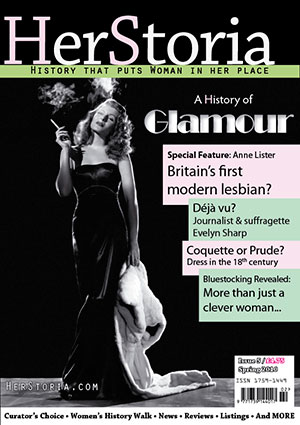
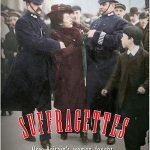



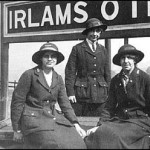
[…] C. (2012). Women and the Bicycle. HerStoria. Available at: http://herstoria.com/?p=315 (Accessed […]
[…] We continued on, locking our bikes, running errands and stopping for snacks. We took a slightly different route home, down low-traffic streets where I used all the hand signals I sometimes slack on and insisted on helmets though she didn’t want to wear one (I know she didn’t think it was “cute” but I said that I thought being brainless would be uglier). Of course I worry about my own safety but having someone in my care puts me on hyper-alert. I’d never want to be a bad role model or ambassador for bikes, especially to a young person. It made me think a lot about how biking has given me such joy and freedom and reminded me of how important the bike was to women’s independence. […]
[…] 20th Century Bicycling Clothing (The Vintage Traveler)Women and the Bicycle (HerStoria) Social Movements and the Bicycle (Thinking About […]